

The following is an an extract from the book "The Role and Status of Women in Sikhism" by courtesy of Dr. Mohinder Kaur Gill. (Some printing errors and grammatical mistakes have been rectified -Kanwal)
THE CONTRIBUTION OF WOMEN IN SIKHISM :
In Sikh religion, no distinction has ever been observed between the male and female. It is another matter that historians have rather delved extensively on the lives of the Gurus but have ignored the lives of the ladies. The social outlook of the Gurus had been well ahead of the time they lived in. Guru history tells us that Guru Amardas had forbidden women to attend the religious assembly in veil (Pardah). He had vehemently opposed the practice of 'Sati'. Bibi Bhani had lived with her son - Guru Arjan Dev Ji like a religious associate, as though in a hermitage, 'Guru Har Rai had trained his daughter Bibi Har Rup Kaur to be the first ever editor of Punjabi literature. The tenth Guru proposed the name of Singh for his men and Kaur for the ladies. In Guru's thinking Singh and Kaur had equal status. The basic sign of equality of the sexes lay in the fact that the Guru gave equal importance to the Singh and kaur: This is also a message of unity and fellowship. If the spirit of unity, equality and fellowship is missing within our own selves how can we make others our own? It is rightly said 'charity begins at home'. The message of equality, unity and fellowship spreads out first from the home itself. Before attempting to illustrate the role and contribution that women played in Sikhism, the author would first like to comment something about their status. Basic reason being, the individuality of a women has a profound role to play in the religious and social context of Sikhism. It is very clear that religious and social values are two sides of the same coin. Religion needs a society and society on the other hand finds a support in religion. The significance of a particular religion can be understood only in the social context. Remarkable it is to note that the status of women in Sikhism has a great relevance in society as well as in context.
In
the true realm of Sikh scriptures divine love has been realised only in abstract
spiritual terms. The inspiration and model for communication that the Gurus of
Sikh scripture sought, while meditating to God and praying for compassion, welfare
and express-ing the experience of union and separation was the model of sacred
love between man and woman. On the one hand, in the medieval period women had
no identity of their own. They were considered a
Commodity, which should be
used as and when, desired - whereas even a commodity has its own value and utility
but the condition of a woman was worse off. Those days women had to face inequality,
discrimination and insults and even class cruelty. Such was the time when divine
contemplation of the Gurus transformed the religion and society. In the tradition
of Sikh scriptures, the sayings of Gurus, Naths and Saints have an important place.
In the compositions of Sidhas, there is the concept of the abstract entities and
both of them are conceptual entities. In the Bani of Nathas there is the concept
of Shiva and Shakti, these two are abstract conceptual entities but it is worth
mentioning one is masculine and the other is feminine. In Nath's compositions
these two entities have divine characteristics.
In contrast of this, the Sikh Gurus have expressed their very presence (individuality) through the women only. This fact is well known that any writer or bard will compare himself to such a thing, which he values and respects. In the creative world of Gurbani, even the worldly activities are expressed symbolically. The many facts of practical living are specially illustrated spiritually in Gurbani is dedicated to the concept that their is only one man i.e. God and the rest are women, that is why the spirit of meditation is so sweetly voiced. The love between man and woman is taken up spiritually and the creative flow of Gurbani has given an important place to woman. Thus the mode of expression in Gurbani based on the model of sacred love between man and woman.
We can get insight from the illustration of love between man and woman that the attitude of Gurus was one of respect towards women otherwise no one would have compared himself to the woman image; and even otherwise in Sikh religion, the shade of spirituality has been compared to the ever lasting wedded bliss.
Guru Nanak Dev has commented significantly at various places about the social entity of woman. In that time there were a lot of superstitions associated with woman. Even in Assa Di Vat; Guru Nanak Dev has indicated clearly about Sutak, and Bhand
Such insulting words were used for a woman that her very name had become associated with that insulting language only. It was only in Assa Di Var that woman was accepted as a basic unit of the society for the first time in medieval literature. Guru Nanak spoke for women in such clear tone and history is a witness that his own sister Bebe Nanaki was the first lady to accept the religious doctrines propounded by him. Thus it is quite clear that still a woman was the first one to accept the Sikh religion. The whole womankind enjoys great respect in Sikh religion. When Guru Amardas estab-lished 22 Manjis to preach Sikh doctrines. 'Matho Murari' and 'Sachan Sach' were the first two women to be deputed to preach them. Along with the 'manjis' he established 72 'cradles' also. The factual importance of which was that while rocking the cradles of their little ones, mothers could also preach about Sikhism and housewives could tell about their religion to everyone in the neighborhood. The result being that all the religious ideas propounded by the Gurus were ingrained in the minds of little children along with their mothers' milk. In medieval time, where such an inferiority complex was associated with women, there, at that time, Guru Amardas blessed the women folk with so much respect that he considered them worth preaching his religion and for that he established the Manjis and Cradles. Such respect was not granted to any women in medieval time by any other religion.
In this context another fact is worth knowing that when Guru Gobind Singh blessed the Sikh men with Nectar, he ordained that Sikh men should use the word Singh and Sikh women should use the word 'Kaur'. These two words Singh and Kaur were to be used in the end of the names of the particular person. This does not mean that the words Singh and Kaur were not used earlier, rather they were in practice in other parts of India also. Worth noting fact is that word Singh has always been used with the name of a man and Kaur with the name of a woman; even before the tenth Guru ordained it. Sikh history tells us that the name of the mother of Guru Angad Dev Ji was 'Daya Kaur' and Guru Ram Dass' was also 'Daya Kaur' and the name of Guru Har Rai's daughter was Roop Kaur. It is evident that the use of word Kaur in the end of a particular name has been there even before Guru Gobind Singh used it. 'Singh' and 'Kaur' words were used with masculine and feminine genders respectively. When Guru Gobind Singh started with the process of building up the nation, keeping in view the separate entity, he told, man and woman to use the words 'Singh and Kaur' in the end of their names respectively. The fact then becomes worth knowing that he granted equal status to both men and women, as well as maintained their respective individualities. Till today the words 'Singh and Kaur' are accepted in Sikh religion as a tradition; and this is apparent that they both denote separate genders.
Here a doubt arises about the expression of spiritual love between man and woman as a model for communication, does that mean the condition of women during medieval times was very oppressed and helpless. It has been indicated that the main model for commu-nication in Guru's poetry is the love relationship between the lover and beloved. A symbol is always ambiguous. It is not meant literally but in reality, the entity of a corporal being is helpless and powerless without the entity of God. A body in a proper manner takes birth, experience the happy and sad things of this world without a choice. In fact, a spirit can never be free from the shackles of death. It is clear that a corporal being is bound under the basic concerns of life without concerning itself with any social inferiority complex or a helpless condition. In fact, the Gurus have respectful attitude towards the women folk that is why; they could compare themselves to the image of woman.
Now a brief discussion about the contribution and the role-played by women in Sikh religion.
In the building up of the character of the Sikh nation, not only did the Gurus play a prominent role, but also even the women of the Guru family had a minor role to play. Here we would look into the invaluable contribution made by those women. We take pride in our heritage but are many a time ignorant of its details and nuances.
Bebe Nanaki
The unique identification of the House of Gurus was established right from the time of Guru Nanak Dev. Bebe Nanaki was the elder sister of Guru Nanak Dev. In these days, out of respect, people used to call the elder Sister 'Bebe'. In the gospels of Guru Nanak, Nanaki has always been called 'Bebe Nanaki' The parents of Guru Nanak were aware of the norms and values that started with Guru Nanak. The Great Guru got involved in practical life but never showed any earnestness like the sons of other businessmen. He did take part in business but never lost himself totally in that. And very soon, he left all mundane business and stared the practice of his religious doctrines
And now arose the problem as to who would look after his family. At this juncture, Bebe Nanaki played a wonderful role, and took care of her nephews and sister-in-law for years together. Apart from this, when Guru Nanak started his missionary work, she not only sent Mardana along with him, but also rendered him the money to buy his first musical instrument i.e.the "Rabab".
The first contribution of Bebe Nanaki was to encourage her brother to preach the musical recitation of hymns and also to make the resources available for him. She mentally prepared Mardana to stay with the Guru and also financed him to buy a beautiful Rabab. The boon of musical recitation of hymns has a prominent place in the Guru family, and Bebe Nanaki played the foremost role in its introduction.

Another tradition determines itself from the behaviour pattern of Bhaiya Jai Ram. Normally, sons-in-law maintain a difference with the family of their in-laws and deal with them accordingly. Even though Jai Ram was Kalu Ram's son-in-law, but he was always like the elder brother to Guru Nanak. He helped Guru Nanak in every task. So much so, that he even found a suitable match for Guru Nanak. Before and after his marriage, he helped Guru Nanak Dev in the business. When Guru Nanak went on his missionary tours, he helped Bebe Nanaki in looking after his family.
It is apparent, that Bhaiya Jai Ram established this tradition in Punjabi culture that even sons-in-law can behave like sons. On one hand he gave due respect to his parents-in-law and on the other he helped his brother-in-law and his family. Whenever the parents of Guru Nanak felt sad, both Bebe Nanaki and Bhaiya Jai Ram like a wise daughter and son made them understand the mission of Guru Nanak Dev.
In this context, the role played by Mata Sulakhni the wife of Guru Nanak Dev, is also unique. Young Mata Sulakhni stayed alone in a lonely house along with her children. She did not go to her sister-in-law's house, neither to her parents, nor to her in-laws. She brought up her children with great patience and inculcated a feeling of self-respect. Mata Sulakhani did feel depressed because she had to live away from her husband, but she never expressed it. Her life style is a beautiful example in itself. One should sacrifice personal comforts for a nobler mission. Mata Sulakhani agreed to stay with her elder sister-in-law, but she never went to her parents' house. Thus, it is evident that for a married woman the husband's house is of foremost importance. She could maintain her grace, dignity and self-reliance. Maybe that is why, Baba Siri Chand the eldest son of Guru Nanak Dev could lay the foundation of 'Udasi-Sant' tradition. Mata Sulakhani spent her days, without any reproach but rather brought up her sons so well that they did not feel the absence of their father, neither did her husband leave his mission unfinished because of domestic cares and worries. The Great master remained out of his home for years altogether but he had always full faith on the family front. May be that is why even today in Punjabi culture, brothers and sisters are main helpers to each other. Mata Sulakhani had to live in absence of her husband and could establish that unspoken uprightness in the pride of women kind.
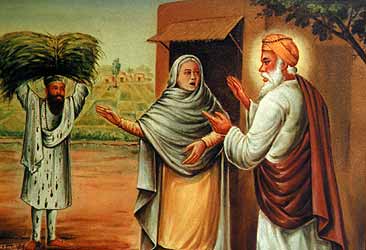
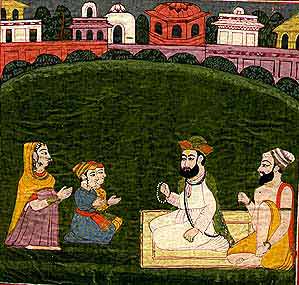
Mata Khiwi was the consort of Guru Angad Dev Ji the second Guru in Sikh religion. Guru family progressed immensely after Guru Nanak. She contributed significantly in realising the ideals of Guru Nanak Dev. The traditions and values established by the First Guru were not changed by his descendents. In his later days, Guru Nanak Dev, laid the foundation of the city of Kartarpur and erected a Dharamsala i.e. a temple or Gurdwara at Kartarpur In this Dharamsala a special code of conduct was also maintained. Bhai Gurdas has indicated in his writings also. In this Dharmsala, holy scriptures were recited twice a day i.e. morning and evening and langar (free Community kitchen) was also served. Thus, establishing a religious tradition. Like a good follower, Guru Angad Dev added another feature and started community kitchen (Langar) in that Dharamsala on a large scale It was open for every one and Mata Khiwi used to manage it. From Mata Khiwi, one can learn not to differentiate between guests One should share, whatever one has. In short, any body could come, sit there and partake of langar There was no discrimination on the basis of caste and creed, rather every body used to sit in a line and have it. Langar is a unique feature of the Guru family.
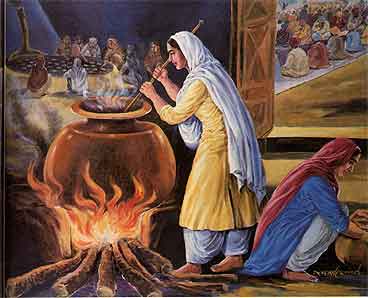

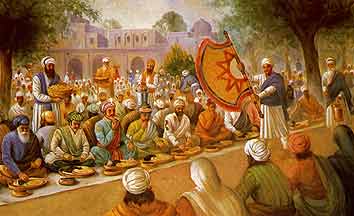
Bibi Bhani
Bibi Bhani, the daughter of Guru Amardas, wife of Guru Ramdas and mother of Guru
Arjan Dev has a distinct place in Sikh history. Mata Mansa Devi, consort of Guru
Amardas, not only maintained her place at home but also helped her husband to
work for the religion. There is special status of Bibi Bhani in the life of Guru
Amardas by the way she cared for her father proving that there was no difference
between a son and a daughter. Both can equally serve their parents. There is a
superstition in Punjabi culture that a father does not get any service done from
the daughter, but Bibi Bhani used to serve her father before marriage and kept
serving him even after her marriage. We can learn a lesson from her way of serving
that one can continue doing worldly duties along with daily religious service
or worship.
Domestic circumstances never became any obstacles and she kept serving her father humbly and with devotion, even after she became the mother of three sons. She very gladly and regularly kept giving bath to her father and used to keep a watch so that no body disturbed him during his meditation. So much so that when a leg of that bath-stool was broken, she kept her arm underneath it, so that his meditation was not disturbed. Only Bibi Bhani could do that.
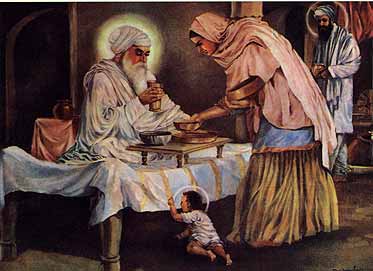
Bibi Bhani was always a helpful companion to her youngest son, Guru Arjan Dev. Life history of Guru Arjan Dev attests that he did many great things simultaneously. Construction of buildings, editing of Guru Granth Sahib and creation of Gurbani in a very large scale were undoubtedly great works. Very patiently she did contribute in all the works. She was the best consultant of Guru Arjan Dev.
When the time of adversity came, the officials of the King Jahangir arrested Guru Arjan Dev, Bibi Bhani maintained her composure and did not let her daughter-in-law Mata Ganga, lose heart. Instead, she very calmly prepared herself for her son's martyrdom and taught her eleven-year old grandson to abide by God's will. She encouraged her grandson, Guru Hargobind, and kept his morale boosted. Bibi Bhani was an embodiment of service, truth and modesty. She was a mark of respect, endurance and of unique character. She was known as "Bibi". In Punjabi culture 'Bibi' is a word which is used to give respect to the daughter. Even Bibi Bhani was a daughter, wife and mother. But the word 'Bibi' could not be disassociated by her name, the reasons being, the unique service rendered by her to her father. In Sikh history, this privilege has been given only to Bibi Bhani. She is the only 'Bibi' in Guru History.
Mata Ganga
Mata Ganga was the wife of Guru Arjan Dev, and mother of Guru Hargobind. She had her only son that too, after a long time of her marriage. Through Mata Ganga, Guru Arjan Dev got one fact determined that even those who serve have immense powers. Had he wished, he could have himself blessed her a son but rather he sent her to Baba Buddha for this blessing. Moreover, he wanted to make it clear to her that we can achieve blessings only through humility. History tells that Mata Ganga along with her maidservants went to have glimpses of Baba Buddha with a great pomp and show. He was displeased on the behaviour of Mata Ganga. Second time, she was persuaded by her husband to go in a very modest manner, as he (Baba Buddha) was a saintly person. Next early morning she herself ground the flour, prepared the food and went to Baba Buddha, while carrying earthen pet (CHAT!) of "Lassi" - a yoghurt derivative - on her head and reciting the hymns denoting utter humility. Baba Buddha was so pleased that he granted her a boon that she will have a son who will be a peerless warrior. Mata Ganga proved that any woman can be worshipped provided she has that qualities of true service and modesty. Service and modesty are even today two important values in Punjabi culture.
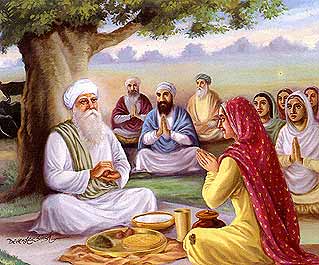
Mata Nanaki
Mata Nanaki was the consort of Guru Hargobind and the
respected mother of Guru Tegh Bahadur. She got married to Guru Hargobind in the
life time of Bibi Bhani and joined the Guru family. Guru Arjan Dev could not join
the marriage of his only son because of his martyrdom in Lahore. She had a very
tough time during the lifetime of Guru Hargobind. Guru Hargobind did not tolerate
the policy of Jahangir the Mughal King He had to fight four wars with the officials
of Jahangir. Naturally, Mata Nanaki was to face all those things that
a warrior's
wife has to. Sometimes she lived in Amritsar and sometimes in Kiratpur and Baba
Bakala in the district of Jalandhar.
After the death of Guru Hargobind, the family of Dheermall becarne the archenemies of Guru Tegh Bahadur. Dheermall was the grandson of Guru Hargobind and the son of Baba Gurdita -the eldest son of Guru Hargobind. Dheermall used to think that 'Gurgaddi' was their heritage right and he should get it; that was the reason he was not in good terms with Guru Tegh Bahadur. Mata Nanki wanted to save her child from the enmity of Dheermall. She brought her saintly son to her parents' house and lived in great poverty. Her son and daughter-in-law was the entire treasure she had at that time. Mata Nanaki used to keep a watch over the meditation basement room and would not let any body disturb her son in his meditation. The life story of Mata Nanaki teaches us that we should abide by the God's will. "If he wants us to rule, we can, but then we do not stand much to gain. We will not lose anything if he wants us to beg." Mata Nanaki availed herself of all the comforts during Guru Hargobind's time but she never lost her composure even in difficult times. She co-operated with her son and when Makhan Shah Lubana announced to the world that he had found the 'Guru', she really thanked God. She lived in a very bad condition, there by illustrating the ideal that one should not be bad equally to bad people because goodness is always rewarded in the end.
Mata Kishan Kaur
The consort of Guru Har Rai was the mother of Guru Harkrishan. She was the younger daughter of Daya Ram, the resident of Anoop city in the district of Bulandshahar in U.P. She belonged to a well-to-do family. Her father was a businessman and an arch devotee of Guru Hargobind. Guru Hargobind went on a tour to preach the ideals of Sikhism in U.P. and agreed upon to marry his son Guru Har Rai to Kishan Kaur, and after marriage he brought his daughter-in-law to Kiratpur. She remained at Kiratpur and followed all the conventions of Guru family. When Guru Har Rai like his father went on his mission towards Malwa, Mata Kishan Kaur had to stay at her in-laws' house and was a great help in managing the affairs of the Gurduara as well as her house. She was a humble and peace loving lady. Her husband died in a very young age of about 32 years. At that time her son Guru Harkrishan was only 5 years old. She looked after her son with love and tender care. Guru Harkrishan was the youngest in Guru's chain. Mata Kishan Kour had to face a very tough time but in all situations she never lost her mental balance and maintained her dignity. When the time came and Mughal king Aurangzeb invited the child Guru, she also accompanied her son to Delhi. She was in Delhi when Aurangzeb and child Guru had some discussions and ex-changed their views. She witnessed the child Guru suffering with smallpox and leaving for heavenly abode. Guru Harikrishan in his young age used to behave like elders and his mother Kishan Kaur would watch him calmly and patiently. She remained in the service of Guru Harkrishan not as a mother but like a devotee and bowed her head before the will of God. Her role as a mother is very peculiar. She was a mother, a companion, a consultant and a devotee from the core of her heart. She never disobeyed the orders of the child Guru and did every thing smilingly.
Mata Gujri
Mata Gujri was the consort of the ninth Guru and the mother of Guru Gobind Singh. When her husband Guru Tegh Bahadur went on a tour to Assam she never lost her spirits. After the martyrdom of her husband she encouraged her son Guru Gobind Singh and was a very helpful consultant and companion to him. Mata Gujri, saw the changes occurring in the Guru family during her life time.
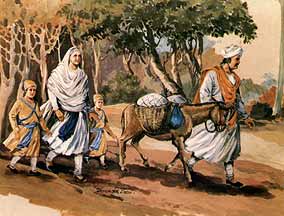
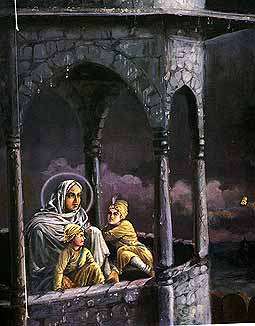
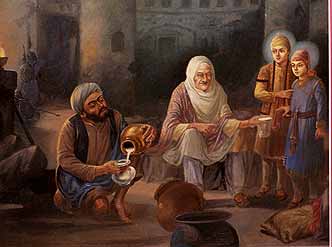
Mata Sahib Devan
The consort of Guru Gobind Singh established a new link in the chain of Guru history. Whereas Bibi Bhani, Mata Ganga, Mata Nanaki and Mata Gujri helped their brilliant sons and enlightened their husbands in every aspect, Mata Sahib Devan guided the descendants of the Guru in various fields. After the death of the tenth master, the Sikhs passed through crisis after crisis but the Mata with her wise leadership always led them to a safe path.
In history, Mata Sahib Devan has a distinct role and place. She hailed from Rohtas, Distt. Jhelum in West Punjab, now in Pakistan. Her father Bhai Rama was an ardent devotee of Guru Gobind Singh.
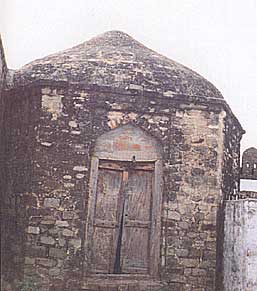
Birth house of Mata Sahib Devan at Rohtas -Jhelum
From her
childhood, Sahib Devan was a sweet and quiet natured girl. Because of the religious
atmosphere at home, she was deeply influenced by the Holy Scriptures during her
formative years. It is possible that in her childhood she might have seen Guru
Gobind Singh at Anandpur during the visit of her family. She had inherited humility,
love and sacrifice to mankind and devotion to God. Mata Sahib Devan is known as
virgin bride in Guru history. All historians agree that Bhai Rama and family members
requested the tenth master in a congregation at Anandpur that they had decided
to give away this daughter in marriage to the Guru and if the Guru would not accept
Sahib Devan, she would remain unmarried all her life. The Guru while accepting
the request of Bhai Rama and the people of Rohtas had stipulated a condition that
Bhai Rama's daughter would live in the family chambers but would stay as a virgin
bride. He would not have any physical relationship with her. The people of Rohtas
were overjoyed on hearing the acceptance of their proposal and she was married
to the Guru. When Guru Gobind Singh created the Khalsa Panth, it was the ideal
wife of the Guru who c6uld be bestowed with the honour of eternal motherhood of
Khalsa Panth. The Mata guided the descendents of the Guru i.e. Khalsa in various
fields. After the death of the tenth Guru, 'Khalsa' passed through a period of
crises many a times but the great mother with her wise leadership always pulled
them out to a safer path -Mata Sahib Devan determined the ideal of bowing before
His Divine Will. Modesty and affection were the unique qualities of Mata Sahib
Devan, due to which she ably guided the Khalsa in their times of crisis. Through
her decrees, Mata the great inspired the Khalsa to serve the house of Gurus or
to help it monetarily for community kitchen (langar). She used to issue edicts
in the name of Khalsa to send money for community kitchen. She helped Mata Sundri
in compiling the creative works of Guru Gobind Singh. After the death of her husband
she lived in the company of Mata Sundri.
Mata Sundri
The ladies of Guru families right from Guru Nanak Dev to Guru Gobind Singh played a very significant role. She remained alive for about 39/4O years after Guru Gobind Singh. Mata Sundri passed away in 1747 AD and Guru Gobind Singh in17O8 AD Mata Sundri was the most significant personality of all the wives of the Gurus. Rather if we say that she was the only personality who led Khalsa Panth for a long time after the Gurus, would be more appropriate. Mata Sundri led Khalsa Panth in all respects. She contributed her mite immensely in building up and strengthening the Sikh Panth, and in keeping the community integration. The question of Tatt Khalsa and of Bandai KhaIsa is the solid proof of this.
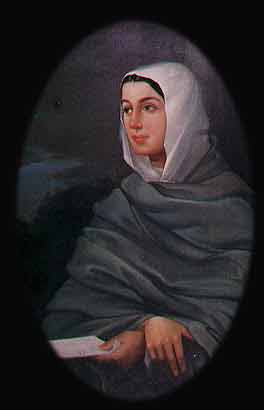
Mata Sundri never forgave such a person who defied Sikh principles and its
code of conduct, may be her acquired son or any other person. When Mata Sundri
was in Delhi, she received the news of martyrdom of her only son Ajit Singh. The
mother's heart cried in pain. She saw a child who resembled her own Son Ajit Singh.
She named him Ajit Singh too. However, he was lacking in all those graces, which
marked the Guru Family.
She was not only a lady of principles, remaining equal
to the task and abiding by her promises, she was very bold and brave too. A woman's
heart and especially a mother's heart are very tender. When the adopted son Ajit
Singh got his hair removed, she kept the softness at bay, and deprived him of
her glimpses forever. It may he possible that Ajit Singh might have thought of
repenting and begging for forgiveness, but she did not allow him a chance for
that because of his abominable sin. Sikhism was ex-tremely dear to the Mata. It
was her heart and soul. One day the starving Ajit Singh came to the threshold
of the mother, then though she consented to given him something to live but she
never looked at him, never allowed him to come near her. She totally cut off the
mother-son relation with him. This incident denotes two characteristics of Mata's
conduct, the Mata was very softhearted but of a determined mind. Mata's justice-loving
disposition could not forgive a son who had gone astray. When the King of Delhi
informed the Mata that men of Ajit Singh had killed an innocent Saint (fakir)
and at the same time he added that Ajit Singh had taken revenge of martyrdom of
Guru Tegh Bahadur, and hence this crime of the Government should be pardoned.
The self-respecting mother did not take the side of her acquired son. Had she
desired she could have saved Ajit Singh. But the intelligent mother was already
aware of its bad effects.
In reality Ajit Singh's hair removing incident
amounted to the loosening of religious and social aspects of the Sikh solidarity.
In that way there was fear of the abandoning of Sikhism on account of the fear
of the Government. Mata Sundri preferred her Sikhs to her adopted son.
She
liked those Sikh sons for whom her revered husband had sacrificed his four endeared
sons. The religious-minded Mata could bear the death of an irreligious acquired
son, but she did not allow Sikhism to be ritualised. The incident of Ajit Singh
brings another aspect of her into prominence, and that is to protect those who
seek her shelter. The starving Ajit Singh could be fed, but he could not be given
the permission to see her. It is, therefore, crystal clear that Mata watched her
principles and promises zealously and vigrously. This very quality distinguishes
her from other women. An ordinary woman does not hesitate to do everything proper
or improper for the sake of her affection but Mata Sundri could strangulate her
affection but not dharma The painful death of Ajit Singh had a healthy effect
upon the contemporary Sikhs. Losing 'Dharma' meant losing life.
Knowing from the King that her acquired son Ajit Singh murdered Benewa Fakir, the Mata should forgive the Government for the Martyrdom of Guru Tegh Bahadur. It brings another fact to light that in those days the Government held the Mata in high esteem The Government considered her a responsible person-ality. Hence, a request for forgiveness was made to her. The Government came to its senses with the reply of fearless and bold mother, and they came to know that the bold and brave daughter-in-law of ninth Great Guru would live with her grandeur of Sikhism who had uttered the following stanza:
"Bhai Kahu Ko Det neh, Nehn bhai manat aan".
(Do not frighten anyone nor be afraid of anybody)
Here' another fact is also
worth mentioning, and hence needs attention. The building of Gurdwara Rakabganj,
the last resting-place of Sri Guru Tegh Bahadur, was constructed under the super-vision
of Mata's husband Guru Gobind Singh. So long as Mata lived in Delhi no bigoted
Mohammedan could dare keep an evil eye upon this shrine. Compelled by circumstances
when she went out of Delhi to Mathura, they became bold and demolished the Gurdwara
build-ing and got a mosque erected at its place. But all this happened in the
absence of her. In reality both the people and the Government considered the Mata
as the central authority of Sikhs and it was true also. During her lifetime the
Great Mata did not allow any signs of weakness in the splendour of the Sikhs.
From social point of view also the Sikhs kept the banner of Sikhism high, and maintained its dignity. Their inferiority complex vanished forever. Wherever the Sikhs were, they lived with self-respect and esteem.
The Mata led the Sikhs with ability in spiritual field as well. Her leadership was solid and constructive in this respect too. She persuaded Bhai Mani Singh, and got established the school of interpretation of Gurus' sacred teachings in Amritsar on the pattern of Damdama school. She got prepared more copies of Guru Granth, the sacred scriptures. She strengthened Damdama School with more vigour and capability. Baba Deep Singh prepared four copies of Adi Grandh, and in addition to that he served successfully both as a granthi and the interpreter. Mata's role as an organiser was prominent in all the above-mentioned tasks. Mata's order is luminously apparent to send holy and valiant Baba Deep Singh to his martyrdom. He was the second prominent personality in Guru House next to Bhai Mani Singh. Mata knew that the blood of the martyrs is never wasted. Hence in those days persons with high calibre were sent for sacrificing their lives. The schools of Gurbani interpretation both at Damdama Sahib and Amritsar carried on their work even after the martyrdom of Bhai Mani Singh and Baba Deep Singh. Many Sikhs benefited by these schools and became prominent preachers of Sikhism. The credit for founding such a centre of spiritualism goes to Guru Gobind Singh, but it is mainly due to Mata's untiring efforts that these centres progressed speedily. The Mata kept on maintaining the speed of their progress even when Bhai Mani Singh was sacrificed.
The great mother (Mata) not only carried on the leadership of the Sikhs of the Punjab only, she looked after all the Sikhs of the rest of India too. This fact is testified and verified by the edicts of the Mata sent in the name of Bihar Patna Sikh congregation and one addressed to Jamania Sikh Assembly. The Sikhs coming from Kabul and Kandhar also considered it as their proud privilege to see the mother (Mata), to obey her and to serve her.
Mata Sundri maintained the cult and traditions of the Gurus by all means. She maintained the tradition of 'langar' i.e. free kitchen, with special efforts. The edicts of Mata Sundri mostly contain the instructions and permission for the Sikhs to send money for the langar: It is guessed that she herself took keen interest for the arrangement of langar and lodging for the Sikh pilgrim. This fact is fully established through the letter of Bhai Mani Singh also that donated money was spent upon running langar: This task of Mata became still more significant when in those days there was no male member in her 'haveli', her place of abode.
Guru family and her adopted son had all passed away turn by turn, and had taken their abode in the Kingdom of God. On the side it was a time of distress for Mata, then her living place was out of the city, thirdly there was no male member nearby. She was carrying on this whole task through the help of her devout Sikhs.
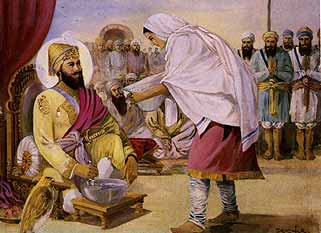
None else except Mata Sundri accomplished the incomplete
tasks of the Tenth Guru. Compared with the rest of the two ladies i.e. Matas:
Mata Sundri was wiser and far-sighted, bold, valiant and patient. See the divine
will, God equipped her most with intrinsic qualities, and at the same time she
had to go through great painful events too. A woman's mind becomes sentimental
at times, becomes gloomy, forebears the pangs of distress, but still she did not
lose heart, and ever remained in high spirits. Mata Sundri's life history stands
witness to this fact that whenever she was in a state of sadness due to circumstances
she changed the situation with great wisdom. Going from Delhi to Mathura and vice
versa frequently testifies the fact
Mata Jito's life characteristics do not
appear to be so glaring. Mata Sahib Devan was very sentimental, possessed tender
disposition, had deep-rooted love for her husband, and she often insisted upon
accompanying her husband. Her quality of obedience was very significant. It is
only Mata Sundri who gives a distinct introduction of her character. Guru Gobind
Singh had prophetically uttered a few words about the acquired Ajit Singh, but
the way in which Mata had prepared herself to bear that heartrending situation
was really appreciable. She did not use a bad word for the boy whom she had accepted
as her son. But when this very son displayed his evil acts, she called him a bad
boy, and then never addressed him as a good boy. It is evident from this fact
that Mata Sundri could take decisions independently and could also face the outcome
of such decisions easily In spite of the martyrdom of four Sahibzadas and heart-rending
news of Mata Gujri's passing away she obeyed her husband's orders to live alone
in Delhi. From this the two qualities of boldness and obedience are seen clearly
The mother Sundri, whose childhood was full of receiving affection and care and who had seen the royal grandeur of her husband and had enjoyed the child like play and games of the four Sahibzadas, had witnessed the hunting expeditions and the wonderful feats of the hawks of her Guru-husband. She enjoyed the devotional love of innumerable Sikhsand had seen the heart-rending sacrifices of warrior Sikhs. The Mata was thoroughly convinced about the poetic capability of her husband and had enjoyed the taste of the spiritual sittings of 52 poets, had to undergo miseries in the last stage of her life. But this high spirited Mata was not carried away by her sentiments. Rather she efficiently led Khalsa Panth in the hours of trials and tribulations. This Mata, the mistress of Guru's royal standing sacrificed her whole family, passed the last ten years in her 'haveli' with the Sikh congregation. But the relieving smile ever remained upon her lip. Before proceeding to her heavenly abode she completed all the duties assigned to her, and with her husband she too occupied the lap of Almighty Lord, Akal Purkh.
In the end, we can aptly say that all the women associated with Guru family did so much work and established so many norms and values that not only helped the immediate generation of the Sikhs but will be useful to the later generation also. The ideals lived by the women of the Guru family are related to family social, political and spiritual fields. Further more literary Contributions are also important. Mata Sundri and Mata Sahib Devan contributed in the editing of the words of the Tenth Guru. Apart from all that, Bibi Roop Kaur, daughter of Guru Har Rai Ji, compiled 32 gospels at one place and emerged as the first woman editor in Guru Family. This compilation of gospels is known as the "Gospels of Bibi Roop Kaur." She is not only the first editor of the literature of Gurus, she is in fact the first editor of Punjabi also.
Other Notable
Women

During the lifetime of tenth Guru, Mai Bhago observed the Sikh norms and rituals very strictly. She not only got the forty deserters forgiven by the Guru, but also fought bravely in the battlefield. For the Guru, she sacrificed everything and reached Nanded. In short, the Sikh women did not lag behind where the preaching of religion was concerned. Instead, even in domestic practical things, the women gave religious norms and values a real meaning We can consider their contribution unique in this aspect.
Conclusion
From the above discussion, we can draw out the following conclusions:
1Bebe
Nanaki is the first woman to accept religion started by Guru Nanak Dev and she
is considered one of the prominent women of the world. Bebe Nanaki helped her
brother mon-etarily for buying his first Rabab for recitation of Kirtan. By taking
care of the family of her brother Guru Nanak, she proved that not only do the
sons help their parents, but also daughters can help and solve their problems.
Secondly the relation between a brother and sister can be so understanding, that
they fulfil the unexpressed desires of each other, and feel a spiritual enjoyment
in helping each other.
2. Mata Sulakhani provided another ideal to the Punjabi
tradition that a husband's home is the best after marriage. If we have to sacrifice
our personal comforts for social welfare, we should do that gladly. During the
religious journeys of Guru Nanak Dev, Mata Sulakhani looked after her sons carefully
and waited for her husband. She never put any obstacles in the missionary work
of her husband. Rather she agreed to whatever her husband said. The silent dignity
of the Mata is a matter of pride for the entire womankind. In the absence of her
husband she did not go to her parents or her in-laws house, rather maintained
her dignity in her own home.
3. Mata Khiwi Ji's name will be associated with
langar in Guru family. Guru Nanak Dev started the tradition of langar at Kartarpur
Sahib. Mata Khiwi devotedly worked for this tradi-tion.
4. From Bibi Bhani's
service we come to know that we should not differentiate between a girl and a
boy. From this aspect, Bibi Bhani has a unique place in Sikh history. Unmarried
and married, she kept serving her father devotedly.
5. The children should
obey their parents. The parents' blessings can even bestow kingdoms on them. Selling
fried-grams Ramdas became Guru Ramadas and Bibi Bhani became Guru's consort and
later on mother and grandmother of the Gurus. No other consort of any Guru has
had such good luck. Bibi Bhani was an embodiment of service, truth and modesty.
6 Mata Ganga's life and character has proved this fact that those who served the
Guru family have been blessed with immense powers That is why the fifth Guru sent
Mata Ganga to Baba Budha for blessing Mata Ganga set up another ideals for the
coming generations Man sometimes falters due to lack of wisdom. However, one should
not despair in adverse times. Instead we should pray to God for patience. Child
Guru Hargobind was only about eleven years of age when his father expired. Mata
Ganga told him to bear everything with patience and saw her son adopting the path
of Mir-Piri.
7 Mata Nanaki was the mother of Guru Tegh Bahadur. She inspired
the child Guru to meditate She kept a watch over the basement when the Guru meditated.
She did not mind the opposition of relatives Instead she always thanked God for
everything. We can get a message from her life and that is, that we should not
copy the evil, rather, God always blesses and rewards goodness in life.
8.
Mata Kishan Kaur looked after the child Guru Harkrishan and faced gracefully all
odds created by her family members or the Mughal King Aurangzeb. She was the embodiment
of endurance and solace.
9. Mata Gujri was the consort of the ninth Guru and
the mother of the tenth Guru. She had immense patience. She was the only woman
in the Guru family who saw the martyrdom of her husband and grandsons. She always
encouraged and inspired her grandsons to adopt the path of Sikhism. She always
told them to face cruelty with dignity and to never lose their religious feelings
and always tried to boost their morale.
10. Mata Sahib Devan kept guiding
her descendants and teach them the principles of life. During her life time after
the death of her husband the tenth Guru she used to get a special vision of Him
from His blessed arms. This was a respect for the arms because they were blessed
and were an image of the Guru itself She established a communion of spiritual
and worldly feelings.
11 Mata Sundri was an embodiment of Sikh ideals. When
her adopted son disrespected the Sikh ideals, she punished him strictly. When
the infighting started among the Sikhs, she saved the situation with a novel plan
In Arnritsar, she started a Taksal to let people know the meanings of the divine
verses of the Gurus which are there in Guru Granth Sahib. She got the divine verses
of Guru Gobind Singh edited by Bhai Mani Singh. She guided the Sikh nation for
a long time. She maintained the dignity of the Gurus in front of the King. Even
if the Sikhs fought with each other, she used to solve their problems and set
everything right. That way the Sikh nation maintained its strength. The Sikhs
did not separate from each other, rather they were a source of strength of each
other.
12. Bibi Har Roop Kaur, the daughter of the seventh Guru was the first
woman editor of the Guru family.
13. The women blessed by the Guru family
also contributed valuably for the House of Gurus, for example, Noorshah at the
time of Guru Nanak Dev. Mata Sabhrai also contributed usefully at the time of
coronation of Guru Angad Dev. Guru Amardas established 22 Manjis and 75 cradles.
Out of which the women used to serve two Manjis and cradles. The housewives also
kept preaching their religion in the neighbourhood. Mai Bhago's contribution at
the time of the tenth Guru is well known
